Plant-based green synthesis of metallic nanoparticles: scientific curiosity or a realistic alternative to chemical synthesis?
Document Type
Article
Publication Date
8-1-2016
Abstract
Currently, thousands of tons of metallic nanoparticles (MNPs) are produced and utilized in nano-enabled devises, personal care, medicinal, food and agricultural products. It is generally accepted that the reaction compounds and the techniques used in industrial production of MNPs are not environmentally friendly. The green synthesis has been proposed as an alternative to reduce the use of hazardous compounds and harsh reaction conditions in the production of MNPs. In this endeavor, investigators have used organic compounds, microbes, plants and plant-derived materials as reducing agents. Research papers are published every year, and each one of them stresses the benefits of the green approach and the advantages over the traditional syntheses. However, after almost two decades since the explosion of the reports about the new approach, the commercial production of green-synthesized nanoparticles does not seem to find a way to scale up commercial production. This review includes descriptions of the traditional and green synthesis and applications of MNPs and highlights the factors limiting the use of plant-based synthesis as a real alternative to the traditional synthesis of MNPs.
Recommended Citation
Peralta-Videa, J.R., Huang, Y., Parsons, J.G. et al. Plant-based green synthesis of metallic nanoparticles: scientific curiosity or a realistic alternative to chemical synthesis?. Nanotechnol. Environ. Eng. 1, 4 (2016). https://doi.org/10.1007/s41204-016-0004-5
DOI
10.1007/s41204-016-0004-5


